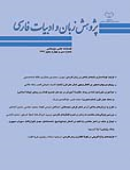ایجاز و حذف در شعر معاصر (با تکیه بر اشعار نیمایوشیج، احمد شاملو، مهدی اخوان ثالث، سهراب سپهری و یدالله رؤیایی)
محورهای موضوعی : پژوهشهای ادبیات کلاسیک ایران
1 -
کلید واژه: شعر معاصر ایجاز سازههای ایجازی حذف شیوههای حذف,
چکیده مقاله :
ایجاز، پیراستنِ کلام از حواشی و عناصرِ غیر لازم است، به گونهای که بیشترین مضمون با ارائۀ کمترین کلمات بیان شود؛ شیوهای که هر چند در ادبیات قدیم نیز به کار میرفته، توجهِ ویژه به آن را باید از مهمترین دستاوردهای شعر معاصر دانست که علاوه بر موجزکردنِ کلام، تحوّلی نیز در سازههای نحوی ایجاد کرده است. توجهِ شاعرانِ معاصر به برخی از این شیوهها، عملاً رویکردی به سازههای زبانیِ کهن است، امّا برخی دیگر، از دستاوردهای زبانیِ ادبیات معاصر محسوب میشود. در این پژوهش، شیوههای رسیدن به ایجاز را در دو گروه عمدۀ سازههای ایجازی و شیوههای حذف، در شعر گروهی از شاعران معاصر بررسی و آنها را با شیوههای حذف و ایجاز در ادبیات قدیم مقایسه کردهایم، با این هدف که در کنارِ شناختِ این شیوهها در شعر معاصر، تأثیر سازوکارهای زبانیِ ادبیات قدیم را بر بخشی از سازههای ایجازیِ شعر معاصر و نیز نوآورانهبودنِ برخی شیوههای حذف را در شعر این روزگار نشان دهیم.
Brevity means decorating speech from additional comments and unnecessary elements, so that the most content may be stated by the lowest number of words; this method, which is also used in old literature but its special consideration is one the most significant successes of Contemporary Poetry, changed the syntactical structures in addition to speech briefing. The focus of some contemporary poets to some of these methods is practically an approach toward old linguistic structures, but some others can be regarded as the linguistic achievements of Contemporary Literature. The article reviews the methods of achieving Brevity in two main groups of brevity and deletion methods in poems of a group of contemporary poets and compares them with deletion and brevity methods in Old Classic Literature; we aimed to show the effect of Old Classic Literature linguistic structures on some part of brevity structures and the degree of innovation in some deletion methods of Contemporary Poem, in addition to identifying these methods in Contemporary Poem.

